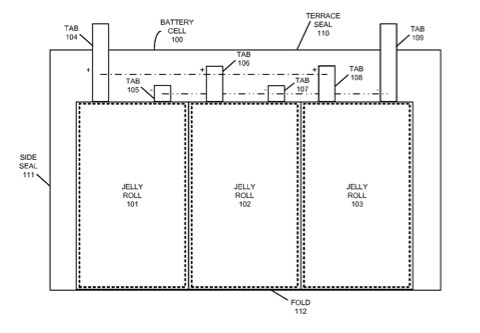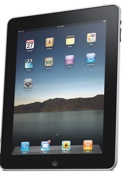Apple has been granted a patent (number 20120107654) for a rechargeable battery with a jelly roll having multiple thicknesses.
This battery cell includes a jelly roll enclosed in a pouch, wherein the jelly roll includes layers which are wound together, including a cathode with an active coating, a separator, and an anode with an active coating. The jelly roll also includes a first conductive tab coupled to the cathode and a second conductive tab coupled to the anode.
The jelly roll is enclosed in a flexible pouch, and the first and second conductive tabs are extended through seals in the pouch to provide terminals for the battery cell. Furthermore, the battery cell has two or more thicknesses, wherein the different thicknesses are created by removing material from one or more of the layers before winding the layers together.
Here’s Apple’s background on the invention: “Rechargeable batteries are presently used to provide power to a wide variety of portable electronic devices, including laptop computers, tablet computers, mobile phones, personal digital assistants (PDAs), digital music players and cordless power tools. The most commonly used type of rechargeable battery is a lithium battery, which can include a lithium-ion or a lithium-polymer battery.
“Lithium-polymer batteries often include cells that are packaged in flexible pouches. Such pouches are typically lightweight and inexpensive to manufacture. Moreover, these pouches may be tailored to various cell dimensions, allowing lithium-polymer batteries to be used in space-constrained portable electronic devices such as mobile phones, laptop computers, and/or digital cameras.
“For example, a lithium-polymer battery cell may achieve a packaging efficiency of 90-95% by enclosing rolled electrodes and electrolyte in an aluminized laminated pouch. Multiple pouches may then be placed side-by-side within a portable electronic device and electrically coupled in series and/or in parallel to form a battery for the portable electronic device.
“However, efficient use of space may be limited by the use and arrangement of cells in existing battery pack architectures. In particular, battery packs typically contain rectangular cells of the same capacity, size, and dimensions. The physical arrangement of the cells may additionally mirror the electrical configuration of the cells. For example, a six-cell battery pack may include six lithium-polymer cells of the same size and capacity configured in a two in series, three in parallel (2s3p) configuration.
“Within such a battery pack, two rows of three cells placed side-by-side may be stacked on top of each other; each row may be electrically coupled in a parallel configuration and the two rows electrically coupled in a series configuration. Consequently, the battery pack may require space in a portable electronic device that is at least the length of each cell, twice the thickness of each cell, and three times the width of each cell.
“Unfortunately, this common type of battery pack design may be unable to utilize free space in the portable electronic device that is outside of a rectangular space reserved for the battery pack. For example, a rectangular battery pack of this type may be unable to efficiently utilize free space that is non-rectangular and/or irregularly shaped.”
The inventors are Ramesh C. Bhrdwaj, Taisup Hwang and Richard M. Mank.



